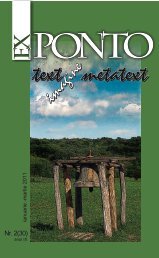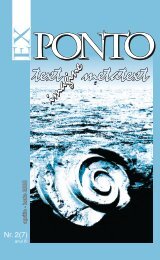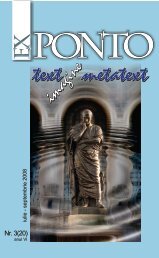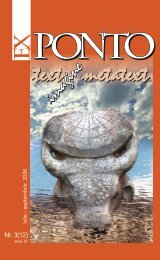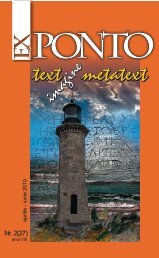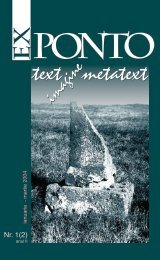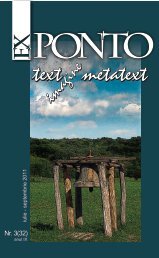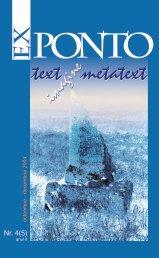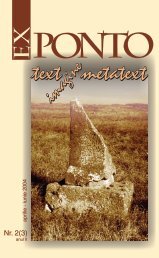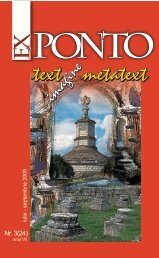Nr. 4 (21) anul VI / octombrie-decembrie 2008 - ROMDIDAC
Nr. 4 (21) anul VI / octombrie-decembrie 2008 - ROMDIDAC
Nr. 4 (21) anul VI / octombrie-decembrie 2008 - ROMDIDAC
Create successful ePaper yourself
Turn your PDF publications into a flip-book with our unique Google optimized e-Paper software.
makes the bird metamorphosize into a beautiful woman. Irrespective of their<br />
original source, Brâncu[i’s sculptures reduce all details, which might have<br />
made the representation look realistic, to the essential form of the object.<br />
The later versions, which were exhibited in New York and Chicago in 1927,<br />
modified the initial position of the bird with the neck bent forward into a more<br />
elongated form. The bird’s head is pointing upward and makes it look like<br />
it is struggling to fly. Other versions, usually called Golden Birds, are even<br />
more slender as if they were propelling themselves into the air. The marble<br />
versions were placed on wooden footings recalling the Endless Column from<br />
the Romanian park in Târgu-Jiu or the fragments from his studio in Paris.<br />
From the first Mãiastra (1910) to the last Bird (1940), the shape became<br />
more and more abstract, loosing the contours which might have identified as<br />
a bird. Brâncu[i challenged the status of sculpture by using an arched shape<br />
to suggest the abstract idea of flight in the absence of a body performing the<br />
act of flying. Representing the non-representational, the sculptor went back<br />
to the Romanian simplistic representations of birds in peasant carpets. He<br />
had to transplant the flat geometric shape from the woven multi-colored fabric<br />
into a tri-dimensional monochromatic body.<br />
These qualities of Brâncu[i’s sculptures were praised in Dorothy Dudley’s<br />
comprehensive critique from The Dial, February 1927:<br />
The first impression was of beauty and real, shapes strong and<br />
important, phases of sphere, disc, shaft, blade, oval, and branching<br />
trunk. Surfaces scintillant, flaming, natural; varyingly warm and cool, not<br />
hot or cold, nor dry or lush, but living. To one staying to know them, birds,<br />
fish, heads, torsos spoke out of these polished marbles and bronzes and<br />
seasoned naked wood. The planes of all were subtle and precise; a look<br />
of ease possessed them. At different heights in the room they balanced<br />
on their bases, cubic, circular, rhomboid, cross-shaped, with a measure<br />
known to jugglers. (1)<br />
Not only does her extensive article follow the traces of Negro art in his<br />
artworks, but it also emphasizes the Romanian background. For Dudley, as<br />
for all the other American journalists who had written about Romania before,<br />
Brâncu[i’s native country is “pastoral,” “remnant of the first Rome,” “a small<br />
fiery fairy-tale of a country.” (5) She herself promotes the already beaten up<br />
clichés of a primitive, but noble heritage. The most insightful part refers to<br />
the influences of Romanian folk art on Brâncu[i:<br />
Shining wheat fields, brilliant stitched borders on sheer white goods,<br />
intricate carvings and tapestries derive from sun and dew of stars. The<br />
people are artist farmers and workmen, who loll close to the ground or work<br />
in patterns up a little into the air, in a gently obscene ∂sic!∑ loam-like hum<br />
of stories shot through with wilder music. To this birth maybe Brâncu[i’s<br />
sculpture owes its primeval strength, as of ancient things-dawn, fields,<br />
planets.<br />
Then these shapes of his have grown in the open web of civilized life<br />
known as Paris. (6-7)<br />
The same appreciations of his simple exoticism can be traced back to<br />
Jeanne Robert Foster’s Note on the Mane and the Formal Perfection of His<br />
Carvings: New Sculptures by Constantin Brancusi in Vanity Fair from the 1922.<br />
If one takes into account the circulation of 99,000 issues and the fact that<br />
Foster’s articles were usually intertwined with very popular advertisements,<br />
there is no doubt that Brâncu[i’s works and his Romanian heritage had<br />
EX PONTO NR.4, <strong>2008</strong><br />
115




